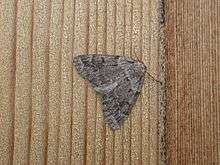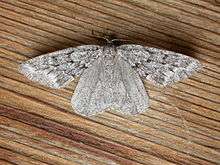Nepytia umbrosaria
Nepytia umbrosaria is a moth of the family Geometridae first described by Alpheus Spring Packard in 1873. It is found in North America, including Arizona, British Columbia, California, Oklahoma, Oregon and Washington.
| Nepytia umbrosaria | |
|---|---|
 | |
 | |
| Scientific classification | |
| Kingdom: | |
| Phylum: | |
| Class: | |
| Order: | |
| Family: | |
| Genus: | |
| Species: | N. umbrosaria |
| Binomial name | |
| Nepytia umbrosaria | |
| Synonyms | |
| |
The wingspan is about 33 mm.[2] Adults are on wing from late July to early August.
The larvae feed on the foliage of Abies amabilis, Abies grandis, Pseudotsuga menziesii var. glauca and Tsuga heterophylla. Mature larvae reach a length of about 35 mm. They have a creamy-yellow body, marked with orange middorsal patches and with a light tan head with dark spots. The species overwinters as a mid-instar larva. Larvae feed from April to June. Pupation takes place in June.[3]
Subspecies
- Nepytia umbrosaria umbrosaria
- Nepytia umbrosaria nigrovenaria (Packard, 1876)
gollark: I kind of miss Windows Phones/
gollark: Slowly, though.
gollark: This is probably in preparation for the inevitable macOS/iOS merger.
gollark: Ah yes, switching architecture, what could POSSIBLY GO WRONG?
gollark: Oh, so it's a worse version of GTech Lavacubes™.
References
- "911339.00 – 6899 – Nepytia umbrosaria – (Packard, 1873)". North American Moth Photographers Group. Mississippi State University. Retrieved April 5, 2019.
- Entz, Chuck (January 19, 2018). "Species Nepytia umbrosaria - Hodges#6899". BugGuide. Retrieved April 5, 2019.
- Natural Resources Canada
This article is issued from Wikipedia. The text is licensed under Creative Commons - Attribution - Sharealike. Additional terms may apply for the media files.